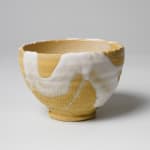Matsutani Fumio 松谷文生 b. 1975
H7.5 x Dia10.8 cm
Further images
-
(View a larger image of thumbnail 1
)

-
(View a larger image of thumbnail 2
)

-
(View a larger image of thumbnail 3
)

-
(View a larger image of thumbnail 4
)

-
(View a larger image of thumbnail 5
)

-
(View a larger image of thumbnail 6
)

-
(View a larger image of thumbnail 7
)

-
(View a larger image of thumbnail 8
)

-
(View a larger image of thumbnail 9
)

-
(View a larger image of thumbnail 10
)

Today’s Japanese ceramic artists have the benefits of great tradition and great freedom, which results in work of deep personal expression. A rising star in the ceramic landscape, Matsutani has won many awards in a competitive Japanese ceramic society. Matsutani’s works blur the line between form and function, utilizing textured polychrome surfaces to draw attention to the ceramics surface. Using clay forms fired over several months, Matsutani defies time, tradition, and gravity as he takes the soaring clay to new heights.
Matsutani bases his studio and kiln in Ehime, on the island of Shikoku. His works are laborious, as he manually incises the surface of his ceramics, producing a textured surface before applying a transparent glaze and firing.
He begins working on his smaller works- such as this sake cup- months in advance. His meticulous hand is seen in the hand-incised textural surfaces that showcase a perfect, monotone yellow, blue, black, or brown. His enquiry into color, surface, and form has frequently been associated with architectural forms. Though Matsutani has never studied architecture, he has taken great interest in the field: “When I go to a bookstore, I tend to go to the architecture section. My teacher, Masayuki Imai, had two tearooms in his studio in Hiroshima.” Masayuki Imai had designed and built these two tea rooms with architects for over a year. With Matsutani observing this process, he began to have an understanding of the architectural design process, bolstering his affinity towards architectural forms and thinking. One can also see the Kogei inspiration in his functional wares. Years earlier, he watched the work of a shrine carpenter for a great while, observing his craftsmanship and cultivating a deeper relationship with craft principles in Japan. While he draws retroactive influence from these events, he currently is also influenced by Western modernist design, a field whose purveyors often work in the intersection between architecture and design. Matsutani is interested particularly in furniture from the 20th century through the likes of Frank Lloyd Wright, and Bruno Taut.









